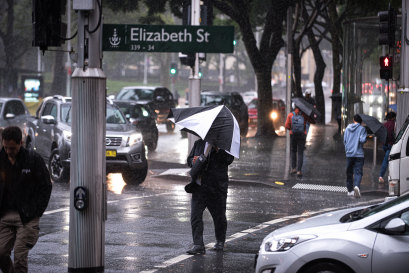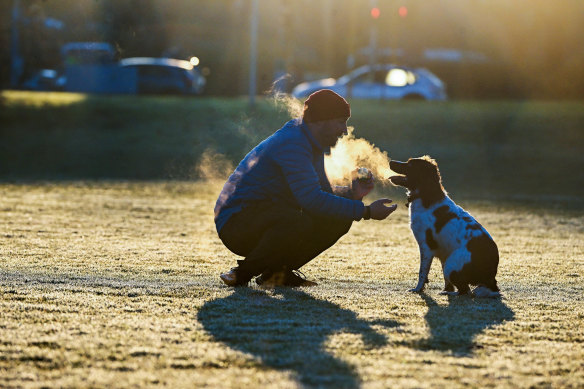Two stars out of 10: Why most Australian homes are poorly heated
By Bianca Hall
As southern Australia continues to shiver through a sustained cold snap, experts have called for a national strategy to improve the energy efficiency of old homes.
Homes built before 2003 have historically poor energy efficiency, leading to higher energy bills and increased greenhouse emissions generated from heating and cooling draughty buildings.

Southern Australia has shivered through a sustained cold snap, such as this downpour in Sydney.Credit: Flavio Brancaleone
An estimated 80 per cent of Australian homes have energy efficiency ratings of two stars or less out of 10 – ratings one expert describes as the equivalent to living in a tent.
For homes built before energy efficiency measures were introduced in 2003, the average efficiency rating was 1.8 stars. It is, says Professor Philip Oldfield, a public policy failure peculiar to Australia.
“A case can be made that we have the most expensive, poor performing housing in the world,” said Oldfield, who is head of school at UNSW Built Environment.
“Millions of homes exist at one star out of 10. If someone scores one out of 10 on a test, it’s fair to say they’ve failed.”

Professor Philip Oldfield says Australia has the most expensive, poor-performing housing in the world.Credit: Louie Douvis
Australian homes are rated between zero and 10 stars, depending on their energy efficiency. A zero-star home is too hot in summer, too cold in winter and requires excessive energy to heat and cool.
In 2003, national building codes were introduced requiring new homes to achieve 3.5 to four-star energy ratings. But for pre-existing buildings, there are no efficiency baselines.
CSIRO senior experimental scientist Michael Ambrose said as many as 80 per cent of Australian homes would now score energy efficiency ratings of two stars.
What does a two-star home look like?
Cost-effective ways to make your home more energy efficient
- Home owners can install or replace old ceiling insulation as the best way to save energy in old properties.
- Door snakes and sealing strips (available at hardware stores) can block draughts from doors and window frames.
- Block openings remaining after appliances have been removed, such as heaters in cupboards.
Source: CSIRO senior experimental scientist Michael Ambrose.
“It’s a draughty home,” Ambrose said. “It’s a poorly insulated home … it’s highly unlikely they’re going to have insulation in the walls. They might have minimal insulation in the ceiling and the ceiling installation will be fairly degraded, so it’d be pretty ineffectual … these are very, very draughty, cold homes.”
Oldfield said power bills in a one-star home could run into the thousands of dollars, while a home with a seven-star rating or higher could cost four times less to heat and cool.
There are, however, simple things we can do to improve our homes’ efficiency. The biggest, and most cost-effective improvement, Oldfield and Ambrose said, was having insulation installed in ceilings and roofs.
Other measures include installing inexpensive sealing tape to block draughts from windows and doors, and plugging holes around the home.

Temperatures across Australia have dipped to unusually low averages over the past fortnight.Credit: Joe Armao
Since 2016, the CSIRO has monitored the energy efficiency ratings of new builds for its Australian Housing Data portal. There is no national database on the ratings of older homes and experts don’t know how many pre-2003 buildings have been renovated to improve their energy efficiency.
Temperatures across Australia have dipped to unusually low averages over the past two weeks, with a sustained high-pressure system driving away rain clouds and leading to clear, cold skies.
While the frigid temperatures are easing, the icy weather has brought renewed focus on the incapacity of many of our homes to withstand extreme temperatures.
Amid cold conditions this week, Oldfield called for a national government-funded strategy to retrofit older homes, pointing to similar schemes in New Zealand and Europe.
Both Oldfield and Ambrose also called for greater transparency on the energy ratings of older homes, so renters and buyers could be prepared for the ongoing costs involved in heating and cooling them.
“We talk about cost, and we talk about carbon, but at the forefront of this is people’s health and wellbeing,” Oldfield said.
“What we’re talking about here transcends carbon and energy. It comes down to people’s lives; mortality, morbidity. More people die from the cold in Australia than in Sweden. It’s shameful.”
A study published in The Lancet in 2015 showed cold caused 6.5 per cent of deaths in Australia – or one in 15 deaths – compared with Sweden, where cold caused an estimated 3.9 per cent of deaths.
Dr Andrew King, a senior lecturer in climate science at the University of Melbourne, said the sustained cooler temperatures were “quite remarkable” given climate change caused warming temperatures.
“We know that we’re seeing less intense cold extremes, and less frequent cold extremes,” King said.
“So as long as we keep warming the planet, we’ll see fewer of these kinds of cold extremes over south-east Australia. But … they’re not just going to disappear. We will still see occasional events like this from time to time.”
Get the day’s breaking news, entertainment ideas and a long read to enjoy. Sign up to receive our Evening Edition newsletter here.